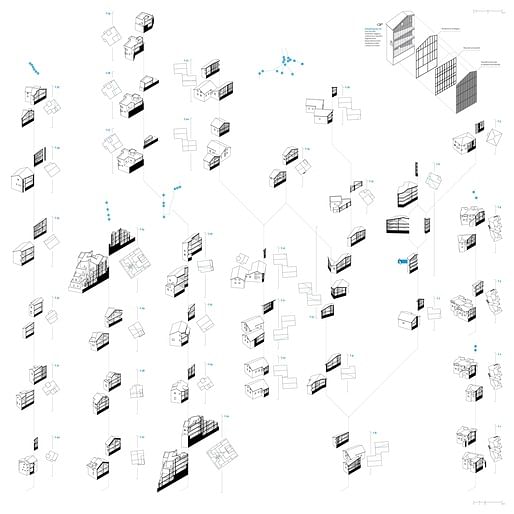

The University of Miami School of Architecture lecture series Call To Order continued this past Wednesday when Matteo Ghidoni of Salottobuono addressed a crowd of faculty and students at Glasgow Hall. This was the second lecture in the series, with the first being Nader Tehrani of Nadaaa. Dean Rodolphe el-Khoury introduced Ghidoni who proceeded to give his lecture called, “Devices in the City”.
The lecture gave a brief overview of projects that fit into the narrative of Call To Order: a reappearance of a larger engagement with history, precedent and typology in the work of many architects practicing around the world. He described Salottobuono as a research based collaborative that began in 2005. His first project referenced was an analysis of Palladio’s Four Books of Architecture, which he re-classified, The Four Books of Mistakes. Ghidoni questions the methods of Palladio’s interpretation of Vitruvius’ writings on architecture. He claims that the text is too obscure, filled with technical language and no drawings. Therefore, the misinterpreted drawings produced by Palladio are flawed. To illustrate this effect, Ghidoni re-interprets the Palladian plates by overlapping the drawings upon each other, removing important segments leaving only numerical figures, in order to capture the “mistake drawings”.

Keeping in theme with the role that drawing plays, Ghidoni spoke about his next project commissioned for the magazine Abitare, called “Instructions and Manuals”. These drawings were beautiful re-drawn representations of various architecture projects, or “devices” as he refers to them, and a comprehensive breakdown of their elements. The various elements would then provide the viewers with a different way to look at the architecture by showing how it interacts within itself but also to its environments. Ghidoni described this sequence as a way to further the public’s understanding of architecture.

Image from Salottobuono.net
A different type of manual presented was the “Manual of Decolonization”, a study using five different techniques to repurpose land in Israel that was original confiscated Palestinian land. The project at first glance seems like an adaptive reuse project, but the methodology presented gives a more complex solution than that. Ghidoni goes through several scenarios, such as “Un-grounding”, “un-homing”, and “un-roofing”, to show the varying potential that architecture can hold on creating new intersections and spaces in this area.

Image from Salottobuono.net
Toward the end of the evening, Ghidoni presented the only built project in his lecture, the Ailati Pavilion for the Venice Biennale in 2010. This pavilion was meant to celebrate Italian architecture with high optimism by showcasing a period of its past, present, and future from a span of 20 years. The entire show was placed in a large warehouse space. Objects were metaphors for these time periods with an almost religious monument-type as the past, and center displays that could be interacted and looked at were the present. As the future is not yet within reach, Ghidoni and his team setup a lifted platform, only accessible from steps underneath, which would take visitors to a different plane within the warehouse.
During the Q & A session afterwards with Dean el-Khoury, Matteo Ghidoni was asked about how he sees history within architecture and his own projects. Ghidoni describes it as a form of collective knowledge, and that we pass or share the ideas to others. At times there is risk for misinterpretation, as illustrated in the first project, but that it’s only an “original sin” or an innocent mistake. Ghidoni went on to speak about how history influenced the name of his archizine, San Rocco. The name emerged from a competition proposal for a housing project by collaboration between Giorgio Grassi and Aldo Rossi that was never built. Similar to them, San Rocco is also a collective effort of not just architects but of photographers and graphic designers. In the end, Ghidoni’s goal is to augment the viewer’s perception of architecture by taking what has been done before and presenting new forms and views on how to reinterpret through creative methods.
This blog gives a sneak peak into the architecture world at the University of Miami. What began as an experiment following one group of incoming graduate students through their first semester of design, has morphed into a window of the school of architecture through this professor's eyes. I will try to post as often as possible.
No Comments
Block this user
Are you sure you want to block this user and hide all related comments throughout the site?
Archinect
This is your first comment on Archinect. Your comment will be visible once approved.